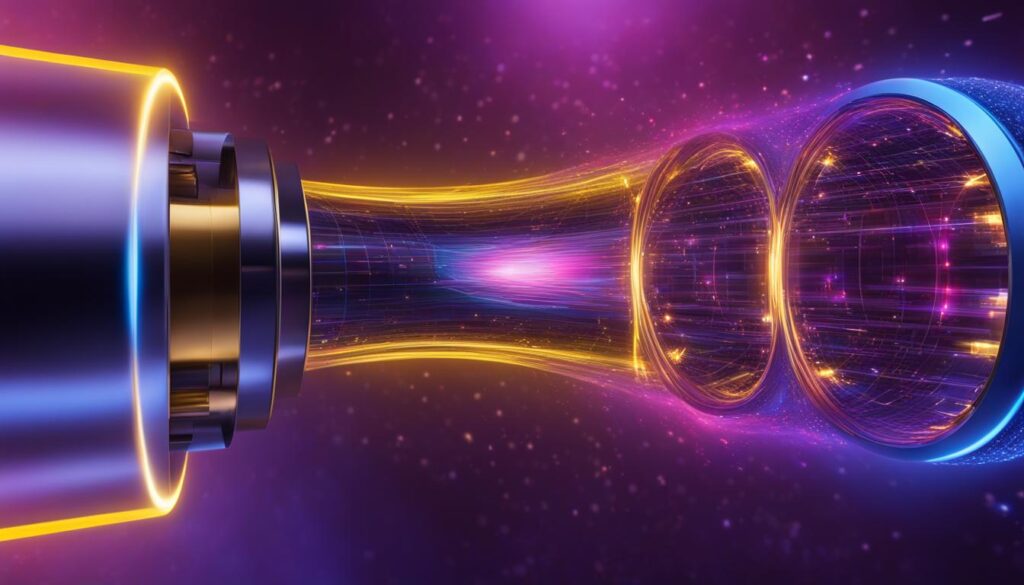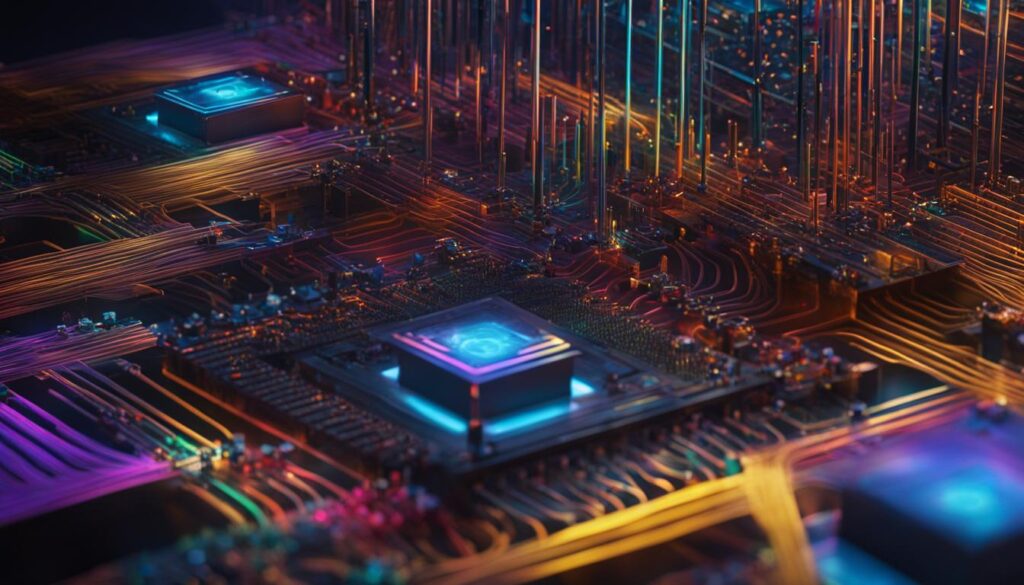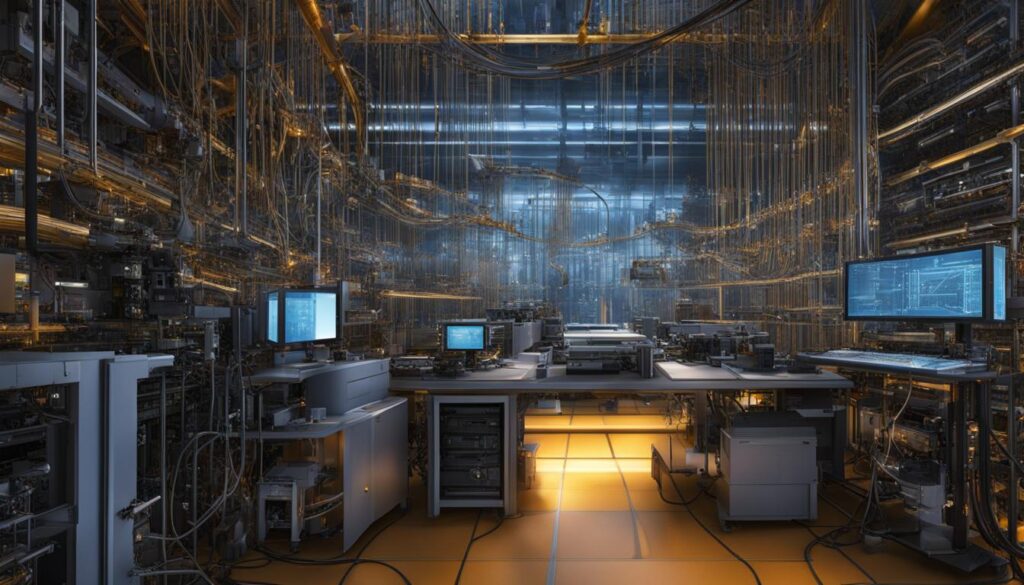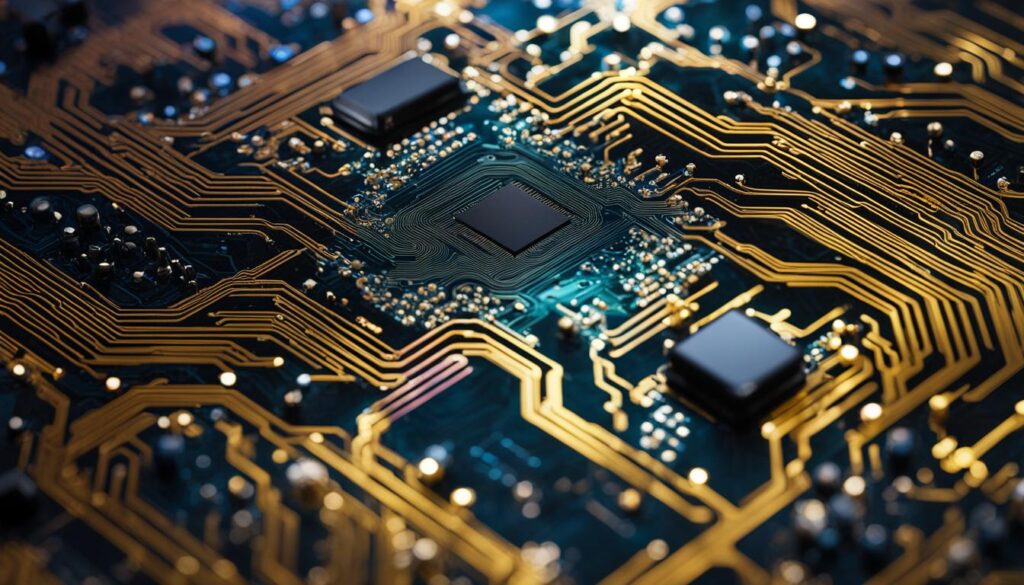Table of Contents
As we stand on the brink of unprecedented technological advancements, one question echoes through the corridors of innovation: What is a Superconducting Quantum Computer? These marvels of advanced computing technology are not merely a step forward; they represent a seismic leap into the future. Employing the principles of superconductivity, where electricity flows sans resistance at critically low temperatures, Superconducting Quantum Computers leverage quantum bits, or “qubits,” to perform intricate computations that traditional machines would find insurmountable. With the potential to revolutionize industries and redefine computational limitations, they are poised to unlock an era brimming with quantum computing potential.
Key Takeaways
- A Superconducting Quantum Computer harnesses superconductivity to perform revolutionary calculations.
- These advanced systems operate with quantum bits, enabling processing capabilities far exceeding classical computers.
- Crucial research in quantum computing unfolds new scientific pathways, pushing the boundaries of what is computationally possible.
- Industry-leading quantum computers like Quantinuum’s H2-1 demonstrate the high fidelity achievable in quantum calculations within the NISQ era.
- The essence of these quantum devices lies in the management of complex quantum systems, promising to illuminate the enigmatic nature of superconductivity itself.
The Quantum Leap: Understanding Superconducting Quantum Computers
Superconducting quantum computers (SQC) represent a true quantum leap in computing, going far beyond the realms of classical computers and capturing the imagination of scientists and engineers alike. When understanding SQC, it becomes clear that their extraordinary potential pivots on a complex yet fascinating concept: these machines can efficiently solve puzzles that are completely out of reach for traditional computers.

The revolutionary strength of SQCs lies in their ability to perform complex quantum gate operations. These operations are harnessed within a **trapped-ion architecture**, which is core to their design. Unlike the binary system of the computers we use today, which calculates using bits in a state of either 0 or 1, SQCs compute with qubits that can exist in multiple states simultaneously, opening up a dimension of computational possibilities.
In the realm of quantum mechanics, a critical focus has been understanding and experimenting with the Loschmidt amplitude—a principle connected to fault-tolerant quantum computing and explored deeply by researchers using SQC platforms such as Quantinuum’s H2-1 system.
Quantum researchers are not only applying quantum computers to important use cases such as logistics and finance but they are also uncovering unknown unknowns—applications barely imagined that could radically transform our approach to the deepest scientific questions.
During this current ‘NISQ’ era, an acronym coined for ‘Noisy Intermediate-Scale Quantum’, SQCs, despite their infancy and imperfections, are already achieving substantial milestones. One particularly noteworthy achievement has been simulating the Fermi-Hubbard model. This model is crucial to progressing our understanding of superconductivity, a facet of quantum physics that could significantly impact energy transmission technologies.
- Recognizing the potential of SQCs in advancing our comprehension of complex quantum systems and phenomena.
- Empowering related industries by implementing quantum-efficient algorithms.
- Setting the stage for future developments in high-temperature superconductivity research.
Table: Highlights of Superconducting Quantum Computers
| Feature | Description | Impact |
|---|---|---|
| Quantum Bits (Qubits) | Units of quantum information that can be in superpositions of states | Allow for massively parallel computations impossible for classically based systems. |
| Trapped-ion Architecture | Utilizes ions as qubits, manipulated by lasers to execute computations. | Enables high-fidelity state preparation, key for error reduction. |
| Fermi-Hubbard Model Simulation | Superconducting qubits model electron interactions in complex materials. | May lead to discovery of materials with unique properties like high-temperature superconductivity. |
| Loschmidt Amplitude | Global observable measuring changes in a quantum system over time. | Critical for understanding phases of matter and fault tolerance in quantum computing. |
The intrinsic complexity of superconducting quantum computers holds the promise of propelling us into an exciting future—a future where the conundrums of high-energy physics, complex molecular structures, and other daunting scientific challenges may be more readily unraveled. With each layer of understanding SQC peeled back, we inch closer to a world where our technologies not only compute but also understand the very fabric of reality itself.
The Core of Quantum: Exploring Quantum Bits and Their Operations
In the revolutionary field of quantum computing, the fundamental unit of information is the quantum bit, commonly known as a qubit. Unlike the binary bits of classical computing, qubits are governed by principles that defy the intuitive rules of our macroscopic world. As we delve into the heart of quantum technology, a deeper understanding of quantum bits reveals why qubits in quantum computing are incomparably more powerful than their classical counterparts.
Defining Qubits in Quantum Computing
Defining qubits is essential for grasping the monumental shift they represent in information processing. At their core, qubits are supercharged with the unique quantum mechanical traits of superposition and quantum entanglement. Superposition allows a qubit to exist in a blended state of 0 and 1 simultaneously, exponentially increasing the information a quantum system can handle. Entanglement, on the other hand, links qubits over any distance, allowing for instantaneous coordination and communication between them.
How Qubits Function Differently than Bits
The difference between classical bits and qubits is stark, heralded by the terms qubits vs. bits. While classical bits are limited to a binary state of either ‘on’ (1) or ‘off’ (0), qubits revel in the phenomenon of superposition in qubits. This capability is not merely an incremental improvement but a transformational leap that allows for vastly more complex and powerful quantum calculations.
The robust nature of qubit functionality becomes evident when we consider quantum entanglement. Entanglement enables qubits to be correlated such that the state of one can instantaneously influence the state of another, irrespective of the physical distance separating them—a concept that traditional bits could never emulate.
Manipulating Qubits for Quantum Calculations
The real magic of quantum computing becomes apparent when we consider qubit manipulation. Utilizing precise and complex strategies, scientists can coax qubits into performing elaborate dances of computing through tailored combinations of microwaves and magnetic fields. These methods have made significant strides since their inception in the late 20th century, showcasing an extraordinary control over quantum states.

Our ability to influence these quantum particles—and consequently the quantum calculations they perform—is made possible by rapidly advancing technologies. The quest for mastery over qubits is a quest for the secrets of the universe, with each improvement in qubit manipulation representing a giant leap towards realizing the untapped potential of quantum computing.
The table below encapsulates the stark contrast between the world of classical computing and the quantum realm:
| Aspect | Classical Bits | Qubits |
|---|---|---|
| State Representation | Limited to 0 or 1 | 0, 1, or both (Superposition) |
| Computation Paradigm | Sequential binary processing | Parallel quantum processing |
| Characterizing Trait | Independence | Entanglement between pairs |
| Manipulation Technique | Electrical signals | Microwave signals and magnetic fields |
| Computational Power | Polynomial scalability | Exponential scalability |
Once you are able to control quantum mechanics, you open up a new world of possibilities.
As we continue to push the boundaries of what is possible with qubit functionality, the future of technology becomes not just improved, but reimagined. Where classical computers march, quantum computers teleport—redefining our very notion of processing and calculation.
The Architectural Marvel: Superconducting Circuits in Quantum Machines
Superconducting circuits are the cornerstone of the technological grandeur in quantum machine architecture. These circuits, characterized by their negligible resistance at extremely low temperatures, serve as conduits for electrons that pair up and travel without the usual scatter and loss associated with normal conducting materials. It’s within these circuits that the remarkable Josephson junctions come into play, highlighting the synergistic blend of physics and engineering expertise manifest in quantum computing.
At the heart of these superconducting circuits is a deceptively simple yet incredibly complex component: the Josephson junction. Composed of two superconductors separated by a thin insulator, they enable the direct observation and manipulation of quantum states. This precise level of control is paramount for the extraordinary capabilities of quantum machines.
“A symphony of superconducting components, each Josephson junction sings in harmony to create the most subtle yet powerful orchestrations of quantum states.”
The architectural mastery of quantum machines arises from the intricate latticework of superconducting circuits. These circuits, much like the neural pathways in the human brain, interlace throughout the heart of the quantum computer, establishing pathways for quantum information to flow effortlessly.
- Seamless electron flow via superconducting circuits enhances computational speed and efficiency.
- Josephson junctions act as gatekeepers for quantum information, controlling electron traffic with high precision.
- Control over quantum states is critical for executing the complex algorithms quantum machines run on.
To further illuminate the sophistication imbued within these quantum machines, consider the following table that encapsulates the elements defining their architecture:
| Component | Function | Significance in Quantum Machines |
|---|---|---|
| Superconducting Circuits | Pathways for nearly resistance-free electron travel | Facilitate swift and lossless information transfer essential for quantum processing |
| Josephson Junctions | Control elements that modulate quantum state transitions | Enable precise manipulation of qubits, critical for quantum computation accuracy |
| Qubit Interface | Medium for qubit interaction and entanglement | Supports complex quantum algorithms and large-scale entangled states |
| Cooling Systems | Temperature regulation to maintain superconductivity | Preserves the integrity of quantum states and the overall stability of the system |
| Quantum State Detectors | Measure and interpret the states of qubits | Provide the feedback necessary for error correction and algorithm tuning |
The finesse required to develop and maintain these superconducting environments bestows upon quantum machine architecture its exalted status in computational science. Venturing into the bowels of these systems, we’re confronted with a labyrinth designed to uphold the delicate dance of quantum states—each movement choreographed to the tune of quantum mechanics and facilitated by the unprecedented characteristics of the Josephson junction.
The dedication to craftsmanship in constructing these machines is a testament to human curiosity and intellect. As superconducting quantum computers forge ahead, breaking new scientific ground, the harmony of Josephson junctions and superconducting circuits continues to underpin this architectural marvel, opening doors to new realms of quantum possibilities.
Chilly Atoms: The Role of Extreme Cold in Superconducting Computers
The silent expanse of a winter’s night holds a secret that is pivotal to the advancement of modern computing: the extraordinary power of extreme cold in superconducting computers. As technological innovators peer into the atomic structure of materials, a chilling realization crystallizes—extremely low temperatures are not just beneficial, but essential for the successful operation of Superconducting Quantum Computers (SQC).
Why Superconducting Quantum Computers Need Low Temperatures
SQC thrive in an environment that is reminiscent of the deepest reaches of space—a realm where the cold reigns supreme and random thermal energy is reduced to a whisper. This is because the act of cooling to near absolute zero does something magical: it quiets the cacophony of atomic vibration, maintaining quantum coherence amidst potential chaos. Thus, the cold is not an enemy of progress, but the guardian of quantum stability.
In order to apprehend why low temperatures in SQC play such a pivotal role, we must delve into the effects of temperature on quantum states. At the level where particles dance on the head of a pin and physics enters a state of wonder, even the slightest warmth can lead to quantum decoherence—an effect akin to untuning a finely tuned instrument, leaving it unable to play the harmonies for which it was designed.
Within the frost-clad walls of a superconducting quantum computer’s heart, the cold is not an austere overseer, but a benevolent force that nurtures the fragile quantum states essential to SQC’s computing power.
Just as a diamond is formed under immense pressure, the intricate conditions within a quantum computer demand exquisitely low temperatures to enable the creation and sustaining of the quantum bits—qubits—that are the messengers of quantum information. It is here, in the calm induced by the extreme cold, that superconductivity finds its breath, granting us access to a realm untamed by classical physics.

To contextualize the mission-critical role of cooling in SQC, consider the following table:
| Aspect of SQC | Effect of Low Temperature |
|---|---|
| Superconductivity | Enables resistance-free electric currents, fundamental for quantum calculations. |
| Quantum Coherence | Preserves delicate qubit states against environmental disturbances and noise. |
| Error Rates | Reduces thermal fluctuations that can induce errors in quantum operations |
| Operational Fidelity | Enhances the likelihood of consistent and reliable results in quantum algorithms. |
From the articulation of complete zero resistance to the cradle of quantum fidelity, the narrative of SQC is one inexorably bound to the pursuit of the deepest cold. In this frost-bitten Eden, researchers forge ahead, leaning on the icy pillars that support the sprawling ambit of quantum computing potential. The task at hand is clear, and the environment in which it flourishes is one with the vast serenity of winter—where the quantum realm finds its silence, and in that silence, its voice.
The Marvel of Zero Resistance: Superconductivity’s Role in Quantum Computing
The quest for zero resistance is not a recent endeavor in the field of physics. However, when it intersects with quantum computing, it paves the way for a paradigm shift in computational capabilities. The elusive state of superconductivity—a state where electrical current flows without energy loss—is at the forefront of this transition. This property is not only pivotal for the advancement of quantum technology but also instrumental in the practical deployment and scaling of quantum computers.
Recent developments in quantum computing have cast light on the intrinsic connection between zero resistance and superconductivity in quantum computing. As researchers and engineers design and operate quantum computers, they are confronted with the challenge of maintaining coherence—a state necessary for quantum computers to function effectively. Superconductivity offers a beacon of hope in this realm, providing a pathway to sustain this coherence by eliminating resistive electrical dissipation.
In a quantum superconductor, particles known as Cooper pairs move through a lattice without the typical scatter associated with resistance. This behavior not only optimizes energy efficiency but also integrates perfectly with the fragile qubits central to quantum computation. Let’s delve into the ways in which superconductivity enhances the quantum computing landscape:
Superconductivity brings to life the fascinating dance of qubits that underpins quantum computing. Without the impediment of resistance, we edge closer to realizing the full potential of these otherworldly computational systems.
- Enhanced Computational Power: By facilitating the flow of electric current without resistance, superconductors maximize the computational power of quantum systems, propelling them beyond the limitations of classical counterparts.
- Stability and Coherence Sustainment: The zero resistance environment prevents the degradation of quantum states, a necessity for maintaining the accuracy of quantum computations over extended periods.
- Energy Efficiency: The absence of energy losses traditionally attributed to resistance translates to energy savings and cost-effectiveness in the long term—the ideal state for scalable quantum computing systems.
Accompanying these advantages, the integration of superconductivity into quantum computing carries the weight of decades of research, from fundamental physics to cutting-edge engineering. The information below provides a snapshot of the symbiosis between superconductivity and quantum computing:
| Superconductivity Impact | Description | Effect on Quantum Computing |
|---|---|---|
| Zero Electrical Resistance | Effectively eliminates resistive losses in electrical circuits. | Enables energy-efficient operations and maintains qubit coherence for superior computational accuracy. |
| Cooper Pair Formation | Bose-Einstein condensate of electron pairs in a superconductor. | Allows for macroscopic quantum phenomena that are robust against disturbances, crucial in quantum error correction. |
| Meissner Effect | Excludes magnetic fields from the superconductor, preserving superconducting state. | Creates an ideal magnetic environment for qubits to operate, free from magnetic noise and fluctuations. |
In view of these profound associations, superconductivity does not merely contribute to the streamlining of quantum computers; it revolutionizes them. It serves as the backbone to the structural integrity of quantum states, guarding against dephasing and ensuring the seamless execution of algorithms essential for tasks unattainable by classical computers.
To conclude, superconductivity’s role in quantum computing is not just foundational—it’s transformative. The marriage between these two disciplines heralds a new era where the promise of quantum supremacy may soon be realized, catalyzing progress in myriad fields, from cryptography and logistics to drug discovery and economic modeling. With superconductivity, we are poised to push these boundaries, opening up vistas of computational potential once deemed the realm of science fiction.

Navigating the Quantum Realm: Applications of Superconducting Quantum Computers
The realm of quantum computing is vast and uncharted, with superconducting quantum computers (SQC) standing as the vanguards of this new frontier. As we venture further into the quantum realm, the applications of superconducting quantum computers show immense promise for transformative changes across various sectors. With the ability to simulate physics at its most fundamental level, SQCs can unravel complexities in material science, renewable energy, and cryptography—areas once restricted by the computational limits of classical computers.
The Impact on Scientific Research and Industry
The impact on research and industry through SQCs is expected to be profound and far-reaching. For instance, in the pharmaceutical industry, SQCs have the potential to accelerate drug discovery processes, simulating molecular interactions at quantum speeds that dwarf the capability of traditional supercomputers. Similarly, in materials science, the quest for high-temperature superconductors could be expedited through SQCs, which can more accurately model the behaviors of electrons in novel materials.
As researchers continue to harness the quantum technology advancement, we stand on the cusp of innovations that will redefine the very bedrock of industry and scientific research.
The following table outlines key areas where superconducting quantum computers are set to make a significant impact:
| Field | Potential Impact of SQCs |
|---|---|
| Material Science | Discovery of new materials with revolutionary properties, advancing electronics, and renewable energy technologies. |
| Pharmaceuticals | Faster, more precise drug interaction simulations, leading to improved medication efficacy and reduced development times. |
| Energy | Optimization of grid operations and development of efficient energy storage systems. |
| Environment | Advanced simulations for climate change predictions and environmental monitoring. |
| Finance | Complex financial modeling for better risk management and market analysis. |
These pioneering applications of superconducting quantum computers not only pave the way for groundbreaking discoveries but also usher in new paradigms for problem-solving within multiple domains. By circumventing barriers that once seemed insurmountable, SQCs are gradually reshaping the landscape of computational research and technological innovation, giving us the means to address some of the most pressing challenges of the 21st century.

SQCs also hold the key to quantum technology advancement with practical applications in logistics, automating and optimizing supply chains in unprecedented ways. As superconducting quantum computers mature, industries from aerospace to automotive are poised to benefit from enhanced optimization capabilities, predicting outcomes and reducing downtime with quantum-level precision.
- Development of more efficient shipping routes and logistical operations.
- Creation of innovative solutions for traffic management and autonomous vehicles.
- Design of advanced security algorithms for cyberdefense strategies.
Indeed, we are merely scratching the surface when it comes to the potential of SQCs. As this technology evolves, the impact on research and industry is expected to cross previously imagined borders, unlocking opportunities that will transform not just how we compute, but how we live.
Precision and Challenges: The Pursuit of Fault-Tolerant Quantum Computing
The roadmap to fault-tolerant quantum computing is paved with innumerable technical hurdles, requiring not just ingenuity but also unwavering commitment to achieving precision in quantum computing. The delicacy with which quantum states must be manipulated, stored, and retrieved demands a degree of precision that is often at odds with the inherently noisy environment of our quantum world full of quantum challenges.
Overcoming these obstacles means addressing issues ranging from qubit stability to the intricacies of error correction protocols. With SQCs susceptible to even the faintest environmental disturbances, the evolution of these systems is undeniably intertwined with our ability to reinforce and extend coherence times. In addition, as we navigate the nuances of quantum error correction, the sophistication of associated techniques broadens the frontier of quantum computational excellence.
As echoed by leading researchers, the masterstroke in our quest for a quantum future will not merely be in wielding these powerful technologies but in refining them to a point where their operations become seamlessly repeatable and remarkably fault-tolerant.
Here, we delve into the essential criteria of fault tolerance that guide the continuous improvement and expected operational excellence of quantum systems:
- Robustness against quantum decoherence and external quantum noise.
- Development of sophisticated error-correction algorithms.
- Implementation of topological qubit systems to enhance stability.
Furthermore, the pursuit of a quantum paradigm where errors are not just detected but preemptively evaded is reflected in the research and development of quantum codes. These codes are not merely mathematical constructs but represent a transformative approach to quantum information processing. They encapsulate the endeavor to abstract the essence of information in a manner that is fundamentally impervious to the corrupting influences of quantum noise.
| Fault Tolerance Component | Challenge | Strategy for Overcoming |
|---|---|---|
| Qubit Coherence | Sensitivity to environment-induced decoherence | Advanced cooling systems, isolation techniques |
| Error Correction | Management of quantum errors in computation | Implementing scalable quantum error correction codes |
| Logical Qubit Design | Physical qubit errors affecting logical qubit integrity | Adoption of topological qubit structures and protocols |
| System Calibration | Alignment of multi-qubit systems for uniform operation | Precision engineering and real-time adaptive control |
Despite these barriers, the edge we seek in quantum computing—where errant bits are but echoes from a classical past—nears reality with each hashtag-infused algorithm and cryogenic breakthrough. The heart of our quantum expedition may beat with quantum uncertainty but is invariably attuned to the metronome of precision.

As we tread carefully on this complex lattice of quantum phenomena, we acknowledge that in the nuances of precision and error correction, lies the key to hitherto unimaginable computational realms. This intricate tapestry, woven from the threads of robust fault tolerance and pristine accuracy, frames the canvas upon which the future of quantum computing will be painted.
The Future Unveiled: Potential Advances and Unimagined Applications
The trajectory of quantum computing is veering into uncharted territories, heralding a new epoch for science and technology. The future of quantum computing is not just about the acceleration of current processes but the inauguration of a realm teeming with next-generation technologies and deep science contributions. Enthusiasts of quantum computing can envisage a reality where this futuristic science not only tackles existing conundrums with unprecedented efficiency but also unveils phenomena that today exist beyond our wildest conjectures.
Contributions to Deep Science and Next-Generation Technologies
Quantum computing stands to extend the frontiers of knowledge across a diverse spectrum of scientific domains. Its ascendancy will likely herald breakthroughs in fields like nuclear physics, unlocking the secrets behind complex subatomic interactions and phenomena. Additionally, as quantum computing matures, it promises to thrust open the gates to realms previously only accessible through theory, offering novel insights into the nature of reality itself.
Quantum computing is analogous to sifting through the cosmic sands with a new found sieve, poised to not only refine our search for the microscopic and gigantic secrets of the universe but also to stumble upon mysteries we haven’t yet thought to seek.
With an emphasis on the development of robust and versatile quantum algorithms, the landscape of technological innovation will be subsequently reshaped. Laboratories and tech companies across the globe, like Quantinuum and NIST, are already laying the groundwork for these exciting advancements. Their studies in measuring phenomena such as the “Loschmidt amplitude” using advanced quantum systems illustrate how deeply rooted quantum science is becoming in our pursuit of understanding complex systems like superconductivity and other phases of matter.
- Exploration of Quantum Computing in modeling complex molecular structures for drug discovery and material science.
- Anticipation of revolutionizing energy systems through the development of high-efficiency superconductors and renewable energy technologies.
- Forecasts of significant improvements in secure communications and cryptography driven by the inherent properties of quantum mechanics.

An illustrative look at the transformative impact of future quantum computing arrives in the form of an insightful table highlighting anticipated contributions to both deep science and next-generation technologies:
| Advancement in Quantum Computing | Deep Science Contributions | Next-Generation Technological Impacts |
|---|---|---|
| Enhanced Algorithmic Efficiency | Accelerated discovery of new physics and unexplained phenomena. | Streamlined data analysis in AI and machine learning, leading to smarter technology ecosystems. |
| Quantum Material Design | Creation of new materials with quantum properties, enabling deeper insights into material behaviors. | Progress in electronics and quantum sensors, yielding more precise measurements and devices. |
| Quantum Machine Learning | Complex pattern recognition within vast data sets, potentially leading to new scientific theories. | Emergence of profoundly intelligent systems capable of human-level intuition and decision-making. |
| Secure Quantum Communication | Reinforcement of cybersecurity methodologies with principles of quantum cryptography. | Robust communication networks impervious to classical hacking strategies. |
The impending future of quantum computing is poised to redefine our approach to the world’s most complex puzzles. As we stand at the brink of this next technological renaissance, we do so armed with a newfound understanding of the quantum domain—a realm pregnant with promise, harboring advancements that defy current imagination.
Conclusion: A Vision of Quantum Ingenuity
As we contemplate the future outlook for superconducting quantum computers (SQC), we must acknowledge the strides made thus far. The culmination of decades of research and experimentation promises a horizon brimming with breakthrough technologies that could alter the fabric of reality as we know it. SQCs, with their unique ability to conduct operations in a realm where traditional computers dare not tread, offer more than solutions to our current computational problems—they provide a platform for discovery in a realm that remains largely untapped and rife with potential.
This technological odyssey has ushered us to the cusp of the SQC culmination, an era where the quantum domain stands ready to unfold its enigmatic layers. As we forge ahead, we become participants in an unprecedented technological revolution, one where quantum machines tackle the unimaginable and transcend the boundaries that have confined our computational capabilities. What lies ahead is a future sculpted by quantum supremacy, with SQCs at its core, weaving a tapestry of advancements once relegated to the domain of science fiction.
In sum, superconducting quantum computers symbolize an intellectual renaissance, a shift that heralds the confluence of quantum physics, material science, and computational excellence. The breakthrough technologies borne from SQCs are not solely incremental improvements upon our existing toolkit; they are the keystones of a new computational architecture. As we behold this striking vista, the journey unfolds, and with it, a kaleidoscope of possibilities that will dictate the role of quantum computing in sculpting a future saturated with the extraordinary.
FAQ
What is a Superconducting Quantum Computer?
A Superconducting Quantum Computer is an advanced computing technology that leverages the principles of superconductivity to enable quantum bits, or qubits, to operate with zero electrical resistance. Capitalizing on superconductivity at extremely low temperatures, these devices can outperform classical computers in solving complex problems, representing a considerable quantum leap in computing potential.
How do Superconducting Quantum Computers represent a quantum leap in computing?
Superconducting Quantum Computers employ high fidelity state preparation and trapped-ion architecture, which allows for precision in quantum gate operations and measurement, especially in the Noisy Intermediate-Scale Quantum (NISQ) era. This enables them to solve specific problems at speeds and complexities that are currently unattainable by classical computers.
What are the defining characteristics of qubits in Quantum Computing?
Qubits, the pivotal units of quantum computing, can simultaneously represent and process multiple states through quantum phenomena like superposition and entanglement. Unlike classical bits that are binary, qubits can encode more information and handle computations exponentially faster than their classical counterparts.
How do qubits function differently than classical bits?
Qubits differ from classical bits in their ability to exist in a superposition of states and to be entangled with other qubits, which allows them to perform many calculations at once. Their quantum properties enable a level of parallelism and interconnectedness in processing information that classical bits simply cannot achieve.
What techniques are used to manipulate qubits for Quantum Calculations?
Qubits are manipulated through precisely-controlled stimuli such as laser pulses or magnetic fields, allowing them to interact and change states in a controlled manner. These manipulations require sophisticated technologies like tunable microwave signals or finely-tuned magnetic fields to achieve the desired quantum calculations.
Why are superconducting circuits significant in Quantum Machine architecture?
Superconducting circuits are crucial because they enable quantum computers to operate with minimal energy loss due to their zero resistance at low temperatures. Components such as Josephson junctions are fundamental in creating and maintaining coherent quantum states necessary for quantum computing.
Why do Superconducting Quantum Computers need extreme cold?
Extreme cold is vital in Superconducting Quantum Computers to achieve and maintain the state of superconductivity, which ensures zero electrical resistance and minimal noise. This cold environment also helps mitigate decoherence, preserving the integrity of the qubits for accurate computing.
How does superconductivity contribute to Quantum Computing?
Superconductivity enables Superconducting Quantum Computers to conduct electricity with zero resistance, which is essential for creating and maintaining coherent quantum states. This allows for more stable and powerful quantum computations compared to systems subject to resistive losses.
What are the potential applications of Superconducting Quantum Computers in research and industry?
Superconducting Quantum Computers have the potential to revolutionize fields such as materials science, cryptography, pharmaceutical development, and energy transmission. Their ability to simulate quantum systems and complex materials with high efficiency could lead to breakthroughs in a multitude of industries.
What are the challenges in developing fault-tolerant Quantum Computing?
The key challenges in achieving fault-tolerant Quantum Computing include maintaining long coherence times, handling environmental disturbances with minimal impact on qubits, and creating robust error-correction algorithms. Overcoming these challenges is crucial for the development of reliable and scalable quantum computing systems.
What does the future hold for Quantum Computing advancements?
The future of Quantum Computing is anticipated to bring radical changes in deep science research and spawn next-generation technologies. It holds the promise of revealing novel scientific phenomena and enhancing computational capacities, resulting in applications that are currently unimagined and solving problems that are unsolvable with existing technology.
